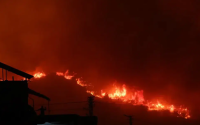17 December 2006The Independent
Midwinter's day may not fall until later this week, but spring already seems to have come to the roof of Europe.
Holiday-makers turning up in the Alps for their annual dose of winter sports are being met by green meadows, not white pistes. Competitors in the skiing World Cup used to be being swaddled in thermals and Lycra, are instead lounging around in T-shirts as their races are cancelled for lack of snow.
Daisies have been poking though the grass at Austria's St Anton resort. Azure Alpine gentians are blossoming even 3,300ft up, while spring forsythia are giving the valleys an unprecedented splash of colour. And over in the French Alps, fruit trees are already coming into bud.
Right across Europe's highest mountain chain, says the World Meteorological Organisation, only a third as much snow as usual has fallen so far this winter. Temperatures are up to three degrees centigrade higher than normal, and in some resorts the weather is so warm that even artificial snowmaking machines will not work.
Hotels throughout the Alps are underbooked; the Italian hoteliers' association reckons that the lack of snow has so far cost its members £400m this year. World Cup races have already been cancelled or rescheduled in France's Val d'Isere and Megève and Switzerland's St Moritz, and one was only able to go ahead in Hochfilzen, in Austria, after local people trucked in 15,000 cubic metres of snow from Grossglockner, the country's highest peak, to create a thin white run through otherwise green pastures.
Local people and tourist officials are doing their best to remain optimistic. "I am certainly not getting nervous," says Wilma Himmelfreundpointer, the deputy director of tourism in St Anton. And 81-year-old Madeleine Villard, in Motte-d'Aveillans, France, adds: "The onions have more layers of skin, which are also thicker, and that means it is going to get really cold." Certainly, a fresh dusting of snow did sprinkle the mountains last week.
But those wishing to consult the authentic harbinger of Alpine spring will find little consolation. Standing on the Promenade de la Treille in Geneva's old town, it is neatly marked with a plaque declaring it to be the city's "official" chestnut tree.
Every spring since 1818, a special city official has watched the tree (and two of its predecessors) to spot when it puts out its first bud, and solemnly record the date on a special noticeboard in the town hall. It usually falls some time in March, though it has at times crept forward into February. But this year, for the first time ever, the tree burst into bloom in late October - and is still sporting flowers and leaves. Winter appears, officially, to have been cancelled.
Human oracles are no more reassuring. Last week the Organisation for Economic Cooperation and Development warned that the Alps are "particularly sensitive" to global warming, and have recently been heating up three times as fast as the world as a whole. It said there would be "even greater changes in the coming decades, with less snow at low altitudes and receding glaciers and melting permafrost higher up".
A two-year study, which the organisation is due to bring out in February, will conclude that at present 609 of the 666 medium to large Alpine ski resorts have adequate snow cover for at least 100 days a year - but that these could drop to just 200 if temperatures rise by four degrees centigrade. This is something that, according to some experts, could happen by 2050, on the worst-case scenario (see graphic above).
Germany would be the worst affected, with just a one degree rise - which the experts say could happen by 2020 - leading to a 60 per cent drop in resorts with reliable snow. In fact, the Alps abound with signs that climate change is already well under way. In the 15 years running up to the turn of the millennium, they lost nearly a quarter of the area taken up by glaciers. And more than another five per cent melted in the blistering summer of 2003 alone. Average snow levels are half what they were 40 years ago.
As the ice that glues them together has melted, huge masses of rock have started detaching themselves from mountains like the Eiger, and whole cliff faces have disintegrated. And the ever-canny Swiss banks have started refusing to lend to ski resorts less than 4,500ft up in the mountains.
But it is not just the Alps that are sweltering in this warmest of winters. Friday was the hottest winter day ever recorded in Moscow at 8.6 degrees centigrade - as opposed to the usual minus four degrees - and the temperature in the Russian capital is expected to climb even higher over the next few days.
Jaguars have ventured out of their warm lairs in Moscow zoo to enjoy the balmy weather, and bears have refused to hibernate. Buds are sprouting on the trees and spring flowers such as violets and coltsfoot are blossoming. The Russian state weather centre says it is refusing to freeze "even beyond the Arctic circle".
In Sweden, where bears are also failing to turn in for the winter, the gingerbread houses that families traditionally make for Christmas are collapsing as the damp, warm weather melts the icing that is traditionally used to stick them together. "The problem is the mild winter," says Aake Mattsson of Anna's, the country's leading gingerbread wholesaler.
Normally frozen golf courses are still playable in Scandinavia, butterflies have been seen on the wing in Denmark, heather is flowering in Poland, pavement cafés are doing a roaring trade in Rome, and people were still sunbathing and swimming on Spanish beaches in November.
And in Britain, bathed in warm southern and southwesterly winds, a bumper raspberry crop was harvested in Northumberland at the end of November, blackbirds are hatching broods in Sussex, and bunches of black grapes are gracing a wild vine in Essex.
Back in the Alps, resorts are beginning to wonder how they will keep their 160 million skier-days of tourist business a year in a warmer world. Some have built spas; others are offering winter hiking packages. And some experts are beginning to predict that one day the winter sport season could move to summer, using roller skis.






